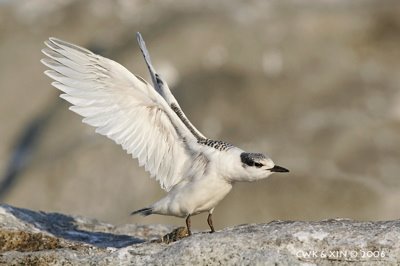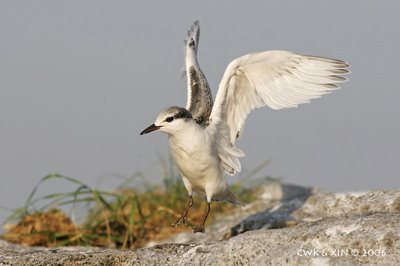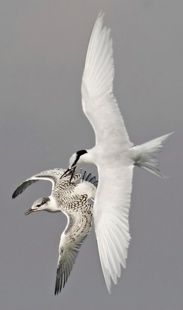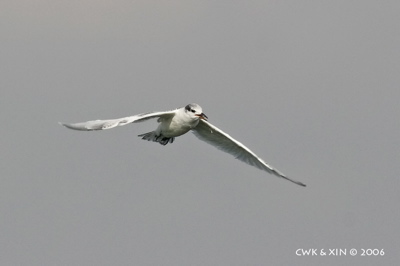Black-naped Tern's first flight
"The Black-naped Tern (Sterna sumatrana) nests in a shallow depression on the rocky surface of small outcrops. Generally, two eggs are laid and incubated by both parents. Soon after hatching, the chicks wander off from the exposed nest to seek shelter behind some boulders or whatever. With the male bird flying off to look for food, the female generally keeps a watch on the offsprings.
 "The period to fledgling is slightly less than a month. All through this period and even after, a chick will continuously beg for food from its parents. Days before fledgling, it will exercise its wings, especially when a strong wind blows through (above). The parent bird would generally refrain from feeding it in an attempt to encourage it to make the first move into flight. No doubt its most anxious moment is just before it attempts at flying.
"The period to fledgling is slightly less than a month. All through this period and even after, a chick will continuously beg for food from its parents. Days before fledgling, it will exercise its wings, especially when a strong wind blows through (above). The parent bird would generally refrain from feeding it in an attempt to encourage it to make the first move into flight. No doubt its most anxious moment is just before it attempts at flying.  "The juvenile will spread its wings, no doubt to understand how the wind catches for lift. With aid from blasts of continuous wind, the juvenile trains for its first liftoff (above). As it experiments further, the parents would keep a close watch to check progress (below).
"The juvenile will spread its wings, no doubt to understand how the wind catches for lift. With aid from blasts of continuous wind, the juvenile trains for its first liftoff (above). As it experiments further, the parents would keep a close watch to check progress (below). 
 "Sometimes it needs a timely peck from the parent to trigger take off (above). This is done when the parent feels that the juvenile is ready.
"Sometimes it needs a timely peck from the parent to trigger take off (above). This is done when the parent feels that the juvenile is ready.  "The magical moment arrives and the juvenile makes its first flight. And I was just as exhilarated and filled with awe as the juvenile itself. Once the juvenile fledges, the parent takes off immediately after it to keep check on its progress and possibly to orientate it on its maiden flight (above).
"The magical moment arrives and the juvenile makes its first flight. And I was just as exhilarated and filled with awe as the juvenile itself. Once the juvenile fledges, the parent takes off immediately after it to keep check on its progress and possibly to orientate it on its maiden flight (above).  "The juvenile, although excited to fly, learns to use its other tail functions, like flap control and maneuvering (above). Once satisfied that the fledgling has mastered the basics of flight, the parent watches from the back, as it tries to glide around (below).
"The juvenile, although excited to fly, learns to use its other tail functions, like flap control and maneuvering (above). Once satisfied that the fledgling has mastered the basics of flight, the parent watches from the back, as it tries to glide around (below).  "The moment of pride for the parent as the juvenile comes in tandem to demonstrate its own proficiency, like a confirmation of flight-hood (below, left).
"The moment of pride for the parent as the juvenile comes in tandem to demonstrate its own proficiency, like a confirmation of flight-hood (below, left). 

"Wary that the juvenile may not have what it takes, especially when a predator is near, it gives a timely peck to bring it back to the landing spot (above, right). The above occur within a short moment that generally escape notice. To be able to catch them on film is both rare and powerful - maybe a chance of a lifetime to experience. Within days after, the juvenile followed its parents on a journey to the ends of the earth (below).
 "Avian photography can be fulfilling - so as long as you keep your distance and do not cause distress to your subjects."
"Avian photography can be fulfilling - so as long as you keep your distance and do not cause distress to your subjects."  Dr Jonathan Cheah Weng Kwong and Xin spent time studying these birds and documenting the various stages of this exciting event as outlined above. All images by Dr Cheah.
Dr Jonathan Cheah Weng Kwong and Xin spent time studying these birds and documenting the various stages of this exciting event as outlined above. All images by Dr Cheah.



4 Comments:
I am afraid it does.
was this observed in Singapore? wow. wish I was there =)
Yes, but don't ask me about the exact location as I do not know.
Hi there everyone I just wanted to say that I liked your site Keep working on it!
Post a Comment
<< Home